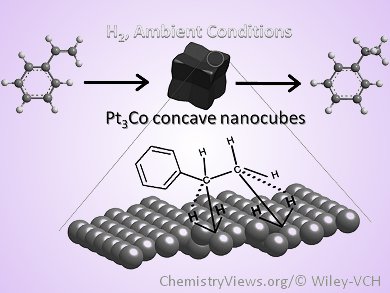Hydrogenation of olefins is often used to test new heterogeneous catalysts, especially noble metals, such as Pt, Pd, and Au. Each crystallographic facet of such catalysts has its own role in the catalysis. For example, {111} planes of Au preferentially activate C=O groups, whereas low-coordinated sites at corners and edges favor the breaking of C=C bonds. It has also been shown that hydrogenation of styrene takes place on defect sites (high-index kinks and steps) of Pd catalysts, rather than their low-index terraces. Thus, the fabrication of nanocatalysts with high-index crystallographic facets could lead to more efficient catalysts.
Jiye Fang, State University of New York, Binghamton, USA, and colleagues report the simple synthesis of high-quality Pt3Co nanocubes (NCs) with a concave structure. The NCs were prepared through a wet-chemical approach, in which the ratio of oleyl amine (OAM)/oleic acid (OA) was finely tuned. The NCs are terminated with high-index crystallographic planes containing a combination of several sub-facets.
The team proposes that the formation of Pt3Co seeds is dependent on the concentration of free metallic atoms during the reaction, whereas the final morphology of NCs was controlled by selective binding with the appropriate OAM/OA ratio during the crystal-growth stage.
Using hydrogenation of styrene as a model reaction, the NCs showed enhanced catalytic activity in comparison with low-indexed surface terminated Pt3Co nanocubes of similar size owing to their more open structure, more stable composition/morphology, and the increased number of active atomic sites located on their high-index crystallographic planes.
- Pt3Co Concave Nanocubes: Synthesis, Formation Understanding, and Enhanced Catalytic Activity toward Hydrogenation of Styrene ,
Chenyu Wang, Cuikun Lin, Lihua Zhang, Zewei Quan, Kai Sun, Bo Zhao, Feng Wang, Nathan Porter, Yuxuan Wang, Jiye Fang,
Chem. Eur. J. 2014.
DOI: 10.1002/chem.201301724




